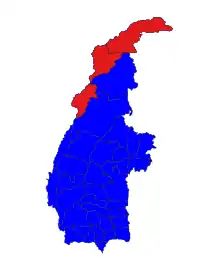Naga Self-Administered Zone
နာဂကိုယ်ပိုင်အုပ်ချုပ်ခွင့်ရဒေသ | |
|---|---|
 Flag  Seal | |
 location in Sagaing region | |
| Country | |
| Region | |
| No. of Townships | 3 |
| Capital | Lahe |
| Government | |
| • Chairperson | Kay Hsai |
| Population | |
| • Total | 116,828 |
| Demonym | Naga |
| Time zone | UTC+6.30 (MMT) |
| Website | Naga Self-Administered Zone |
The Naga Self-Administered Zone (Burmese: နာဂကိုယ်ပိုင်အုပ်ချုပ်ခွင့်ရဒေသ [nàɡa̰ kòbàɪɰ̃ ʔoʊʔtɕʰoʊʔ kʰwɪ̰ɰ̃ja̰ dèθa̰]), is a self-administered zone in the Naga Hills area of Sagaing Region of Myanmar. Its administrative seat is the town of Lahe.[2]
History
The Naga Self-Administered Zone was created under the terms of the 2008 Constitution of Myanmar.[3] Its official name was announced by decree on 20 August 2010.[4][2]
In August 2016, an outbreak of measles caused the deaths of 44 children.[5][6] The outbreak may have been caused by a lack of measles vaccinations due to poor health infrastructure.[7]
Government and politics
The Naga Self-Administered Zone is administered by a Leading Body, which consists of at least ten members and includes Regional Hluttaw (Assembly) members elected from the Zone and members nominated by the Armed Forces. The Leading Body performs both executive and legislative functions and is led by a Chairperson, currently Kay Hsai.[8] The Leading Body has competence in ten areas of policy, including urban and rural development, road construction and maintenance, and public health.[9] Though the region does not lack medical infrastructure, it only had two medical doctors for around 130,000 residents as of May 2020.[10]
Administrative divisions

The zone is made up of the three townships:[11]
Subtownship
- Donhee
- Htanparkway
- Mobaingluk
- Pansaung
- Sonemara
The three townships were previously part of the Hkamti District prior to the creation of the Naga Self-Administered Zone.
In 2015, it was proposed that Hkamti and Homalin townships be added to the Naga Self-Administered zone. This was welcomed by ethnic Nagas but came against opposition from other ethnic groups in the townships.[12]
Demographics
The zone was created to be self-administered by the Naga people. Two-thirds of the Naga people in Myanmar are Christian and one-third practice Theravada Buddhism.[13]
In total, nearly one million Nagas divided into 10 tribes live in Burma. But the majority of them live outside the Naga Self-Administered Zone (mostly in Western Sagaing Division). Naga Self-Administered Zone is consisted of a total of 270 villages. According to the Census of 2014, the total population within the Zone is 62,766. However, according to the administration of SAZ, the total population as of 2018 is 127,439.[14]
In terms of ethnicity, out of a total population of 127,439, the majority are Naga (122,239 or 95.9%). Chin (2,893) and Bamar (2,156) are also present in Naga SAZ. As far as religion is concerned, there are 93,188 Christians (73.1%) and 31,969 Buddhists (25.1%). There is a small population of 2,070 (1.6%) who follow traditional religion, mostly in Lahe.[15]
See also
- Naga people
- Naga Hills
- Nagaland, a Naga majority state in India
References
- ↑ Sagaing Region. The 2014 Myanmar Population and Housing Census. Vol. 3-E. Naypyitaw: Ministry of Immigration and Population. May 2015. p. 17.
- 1 2 Xinhua Staff (21 August 2010) "Myanmar re-designates areas under new constitution ahead of election" People's Daily Online, last accessed 5 October 2010
- ↑ "Online Burma Library > Main Library > Law and Constitution > Constitutional and parliamentary processes > National constitutions, draft constitutions, amendments and announcements (texts)". www.burmalibrary.org. Retrieved 24 February 2019.
- ↑ "တိုင်းခုနစ်တိုင်းကို တိုင်းဒေသကြီးများအဖြစ် လည်းကောင်း၊ ကိုယ်ပိုင်အုပ်ချုပ်ခွင့်ရ တိုင်းနှင့် ကိုယ်ပိုင်အုပ်ချုပ်ခွင့်ရ ဒေသများ ရုံးစိုက်ရာ မြို့များကို လည်းကောင်း ပြည်ထောင်စုနယ်မြေတွင် ခရိုင်နှင့်မြို့နယ်များကို လည်းကောင်း သတ်မှတ်ကြေညာ". Weekly Eleven News (in Burmese). 20 August 2010. Retrieved 23 August 2010.
- ↑ "Measles death toll reaches 44 in Naga | Eleven Myanmar". www.elevenmyanmar.com. Archived from the original on 19 August 2017. Retrieved 20 August 2016.
- ↑ "WHO doctors in Myanmar's Naga areas identify 'mystery disease' – Eastern Mirror". www.easternmirrornagaland.com. 6 August 2016. Retrieved 8 August 2016.
- ↑ "Myanmar (02): (SA) fatal, measles conf". www.promedmail.org (Archive Number: 20160806.4398118). International Society for Infectious Diseases. Retrieved 8 August 2016.
- ↑ http://www.msco.gov.mm/en/latest-news-news/union-minister-u-kyaw-tint-swe-meets-officials-naga-self-administered-zone
- ↑ "Nagaland: A frontier, for now". 9 April 2019.
- ↑ Lei Lei (21 May 2020). "Myanmar's Remote Naga SAZ Has Only Two Doctors for Its 130,000 Residents". The Irrawaddy. Retrieved 19 May 2022.
- ↑ ပြည်ထောင်စုသမ္မတမြန်မာနိုင်ငံတော် ဖွဲ့စည်းပုံအခြေခံဥပဒေ (၂၀၀၈ ခုနှစ်) (in Burmese). 2008. Archived from the original on 19 November 2015.
- ↑ "Naga zone expansion plan sparks protests, petitions | The Myanmar Times". 2 February 2015.
- ↑ "The Naga tribes of Myanmar - The Boston Globe". The Boston Globe. Retrieved 10 August 2016.
- ↑ https://meral.edu.mm/record/1387/files/Nu%20Sandar%20Li%20(MDevS%20-%2015).pdf
- ↑ https://meral.edu.mm/record/1387/files/Nu%20Sandar%20Li%20(MDevS%20-%2015).pdf
.svg.png.webp)
